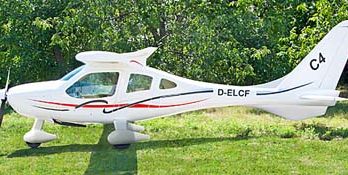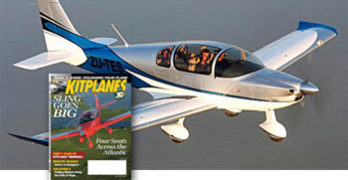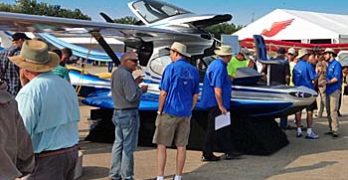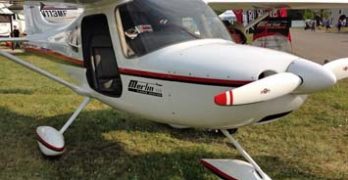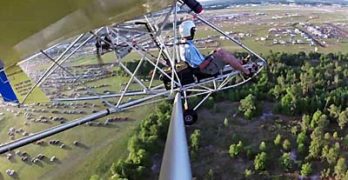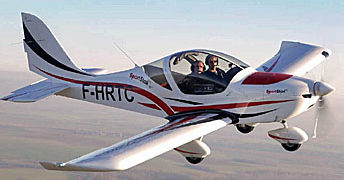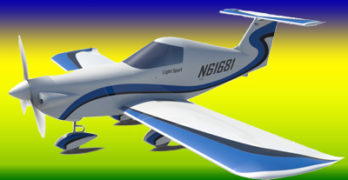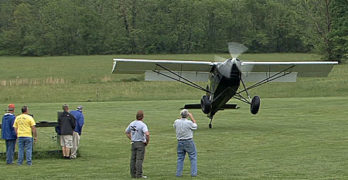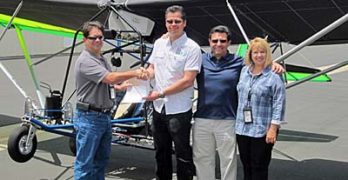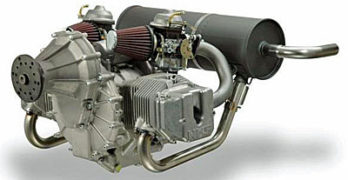For more than 100 years, cars have had accidents and if they were severe enough, the results were poor (photo). This was long before seat belts, airbags, breakaway steering columns, padded dashboards, and many other features we take for granted today. It was also before the concept of crumple zones. Typically, crumple zones are located in the front part of the vehicle to absorb the impact of a head-on collision because 65% of crashes are frontal impacts, according to a British study. Crumple zones accomplish two safety goals: They reduce the initial force of the crash; and they redistribute the force before it reaches the vehicle’s occupants.This idea has been around more than 60 years and has become standard in the modern era of passenger car design. One of the first examples of crumple zone research is coming from Mercedes-Benz in the mid-1950s, so perhaps it is fitting that some of the first crumple zone technology to be applied to light aircraft has the sponsorship of the German government along with German industry players.
Is This the “New GA?” … LSA Four Seaters
Something of a stealth invasion is beginning. I refer to an emerging flock of four seat Light-Sport Aircraft. Of course, most readers are aware that no such birds exist as LSA (in the FAA’s code, anyway). By U.S. regulation Light-Sport are two seat aircraft. Other nations have some different ideas. For now, suffice it to say the “LSA 4s” — as I choose to call them for this article — are on final. In the past I’ve written about Evektor’s Cobra, one of the first in this group, arriving so early that you probably would not call it a “LSA-like” airplane. The southern Czech company enjoyed success with their SportStar and Harmony, smaller siblings to a four seater they flew several years ago. After Evektor (coincidentally also the very first LSA to be approved), we began to hear about Flight Design’s C4 modeled on their LSA market-leading CT series.
Post-AirVenture 2014 News Review
Summer’s big show is over and most aviation business folks are back home having that love/hate affair with email that piled up while we worked the event. On whole, the success story is strong. Airplanes sold, crowds were good, accidents were few, and the weather was not smoking hot like it has been in years past (though brief rain showers kept folks dashing for cover on occasion). EAA says attendance was up from last year, that the numbers of airplanes was higher, and that campgrounds reached capacity by midweek. EAA’s special 10th Anniversary of Sport Pilot/Light-Sport Aircraft Exhibit drew well all week with 17 aircraft representing all sectors within the SP/LSA space. Visitors could hardly miss the wonderfully central space AirVenture planners offered for this one-year display. With the front corners presenting a bright green Van’s RV-12 plus the freshly debuted MVP seaplane attendees were practically compelled to wander the space and see all the flying machines.
Glasair Shows Merlin Mockup; Will Build MVP
Although not previously known for any involvement in the Light-Sport space, longtime kit aircraft producer Glasair Aviation is jumping in assertively for 2014. At Sun ‘n Fun, the Arlington, Washington company debuted their Merlin and to AirVenture 2014 they brought a full-size mockup. They also participated in the standing-room-only press briefing for the new MVP.aero seaplane. Why? Because Glasair will be one of two initial build locations, handling the Western states while Port Orange, Florida-based Fibercraft will produce for Eastern states. I’ll offer more on the MVP arrangements in another report on that header-turner design unveiled at AirVenture. Yet this association means Glasair will go from no presence in LSA to taking a significant position in short order. MVP production won’t start for more than a year, but Glasair’s Merlin project is ambitiously aiming to hit the market in 2014, according president Nigel Moll. Glasair is famous for the their flagship Glasair II and III, speedsters of the sky in the Experimental Amateur Built category and for their well regarded Sportsmen two seater.
Zigolo Cracks the China Market as Part 103!
I didn’t see this one coming. Maybe you didn’t either? In the new millennia gold rush represented by companies either being bought by Chinese businesses or gaining investment from wealthy Chinese business people or by setting up shop to sell in China (or even Cessna’s ill-fated effort to have their Skycatcher manufactured in China), one element I’ve never heard of is Part 103 in China. This least-regulated-of-all aviation category is solely an American thing, isn’t it? Well … yes and no. Germany has opened the door to a Part 103-like development in that country under the 120-kilogram class (using a number that is 264 pounds or very similar to Part 103’s 254-pound empty weight limit). England has their SSDR class (SSDR being the abbreviation for Single Seat De-Regulated). Despite following those developments, I’ve never heard a word about China and any less-regulated sector.
“The first Zigolo in China was introduced to the public in that nation on July 17th at the Jingmen Airshow,” reported representative Chip W.
Evektor with Dynon Earns EASA Type Certificate
The very first aircraft ever to receive approval in the USA as a Light-Sport Aircraft is Evektor-Aerotechnik’s SportStar. No challenger can ever take away that title yet the company has continually developed this pioneeering airplane and recently achieved a new level of approval … one that alters the landscape in a way I predict we’ll see more as FAA’s Part 23 rewrite project progresses. “Following several months of certification process EASA has approved glass cockpit Dynon SkyView [as] SportStar RTC,” Evektor announced. RTC stands for Restricted Type Certificate. It is not identical the U.S. Part 23 Type Certificate — representing a somewhat lower level of government oversight — but a company earning this has to jump through many regulatory hoops. “SportStar RTC has become the first EASA certified aircraft approved with the SkyView glass cockpit [by proving] compliance with certification requirements of the EASA CS-LSA regulations. Dynon’s SkyView, recently upgraded to permit touch functionality, is widely known and used on Light-Sport Aircraft.
SkyCraft Airplanes Finishes ASTM Compliance
While so many continue to say you can’t buy a Light-Sport Aircraft for less than — pick a number … $100,000 … $150,000 — the truth is something else. We already have modestly priced entries from Quicksilver, BushCat, X-Air, M-Squared, plus several weight shift or powered parachute entries. Another that burst on the scene a couple AirVentures back was SkyCraft. The Czech design that a group in Utah are Americanizing is a fully enclosed, well-equipped single seater. Not many singles have been offered (Tecnam‘s aerobatic Snap is one such) yet the fact remain that much flying is done solo anyway, so why not have a sharp airplane for your own aerial enjoyment. Plus, what if you can fly it away for less than $60,000? Not every pilot will find SkyCraft SD-1 Minisport sufficient and lucky for those aviators, plenty of choices are available if you have to have 1,000-mile range, autopilot, big dual glass instrument panels, and of course, two seats.
SuperSTOL to Perform at Just Plane Fun Days
Airplane-brand-specific fly-in events can be fun and informative. If the folks at Just Aircraft are involved and if they show off their amazing SuperSTOL, a company fly-in takes on a new level of excitement. Those of you who have stopped by their airshow display to speak to the people from Just Aircraft know the Walhalla, South Carolina manufacturer is composed of a bunch of individuals that seem so laid back, you could wonder how they get so much work done. They do, by the way, having produced and delivered more than 500 aircraft kits. Since 2012 — when they introduced their at-the-time-unnamed SuperSTOL to slacked-jawed response from crowds — Just Aircraft reported kit sales have more than doubled requiring the company to add a second shift to keep up with demand. How many other companies do you know with that need? All seriousness aside for a weekend, though, those Just Aircraft’ers know how to have a good time, too.
Quicksilver Ready to Build Special LSA
Plenty of longtime light aircraft enthusiasts have wondered when Quicksilver would enter the SLSA sweepstakes. “On June 26th we received the airworthiness certificate and the operations limitations document for our Sport 2SE Special LSA after a three-hour inspection from the FAA,” said Quicksilver Aeronautics President and CEO, Will Escutia. Earlier the company reported successfully passing an intensive FAA audit, but a final aircraft inspection by FAA personnel was still needed. Aviation Safety Inspectors, John Soltis and Kym Robbins, provided the pink airworthiness card at the French Valley Airport (photo), approximately 10 miles from the company’s factory. Soltis expressed his congratulations saying the airplane “looked very good.” At near the industry’s lowest cost — $39,999 for a fully built Sport 2SE — those Light-Sport fans who fret about the high cost of some (exceptionally well equipped) airplanes now have a very affordable choice. If $40 Grand is still too much you can buy a Quicksilver ELSA or Experimental Amateur Built for even less.
HKS Four-Stroke Engine is Back on the Market
A majority of pilots express a preference for four-stroke engines due to their lower noise signature, reduced fuel consumption, ease of fueling and other reasons. For larger aircraft, engines from Rotax, Continental, and Jabiru may be preferred choices but for lighter aircraft most of these engines are more than needed (though the 80-hp Rotax 912 UL and 81-hp Jabiru 2200 can work for some intermediate-sized light aircraft). All the preceding engines are more costly as well. One popular, economical choice was the HKS from Japan but that well-regarded engine appeared destined to disappear from the American market, a shame as it is one of only a few engines to have successfully complied with the ASTM standards needed for use on LSA. No such FAA acceptance is needed for Part 103 ultralight vehicles or Experimental Amateur-Built aircraft. Fortunately, to paraphrase Mark Twain, “Reports of [the HKS] death were greatly exaggerated.”
Earlier in 2014, HKS discontinued production of HKS-700E and HKS-700T.
- « Previous Page
- 1
- …
- 8
- 9
- 10
- 11
- 12
- …
- 52
- Next Page »


